Pope Felix I was the bishop of Rome from 5 January 269 to his death on 30 December 274.

Hilary of Poitiers was Bishop of Poitiers and a Doctor of the Church. He was sometimes referred to as the "Hammer of the Arians" and the "Athanasius of the West". His name comes from the Latin word for happy or cheerful. In addition to his important work as bishop, Hilary was married and the father of Abra of Poitiers, a nun and saint who became known for her charity.

Germain was the bishop of Paris and is venerated as a saint in both the Catholic Church and the Eastern Orthodox Church. According to an early biography, he was known as Germain d'Autun, rendered in modern times as the "Father of the Poor".

Venantius Honorius Clementianus Fortunatus, known as Saint Venantius Fortunatus, was a Latin poet and hymnographer in the Merovingian Court, and a bishop of the Early Church who has been venerated since the Middle Ages.
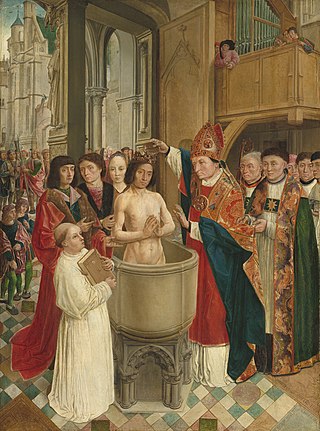
Remigius was the Bishop of Reims and "Apostle of the Franks". On 25 December 496, he baptised Clovis I, King of the Franks. The baptism, leading to about 3000 additional converts, was an important event in the Christianization of the Franks. Because of Clovis's efforts, a large number of churches were established in the formerly pagan lands of the Frankish empire, establishing a distinctly Orthodox variety of Christianity for the first time in Germanic lands, most of whom had been converted to Arian Christianity.

Peter Chrysologus was Bishop of Ravenna from about 433 until his death. He is known as the "Doctor of Homilies" for the concise but theologically rich reflections he delivered during his time as the Bishop of Ravenna.
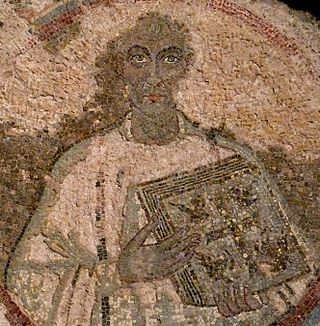
Quodvultdeus was a fifth-century Church Father and Bishop of Carthage who was exiled to Naples. He was known to have been living in Carthage around 407 and became a deacon in 421 AD. He corresponded with Augustine of Hippo, who served as Quodvultdeus' spiritual teacher. Augustine also dedicated some of his writings to Quodvultdeus.

Saint Proculus (Proclus) of Pozzuoli was martyred around 305 AD, according to Christian tradition, at the same time as Saint Januarius.

The Catacombs of San Gennaro are underground paleo-Christian burial and worship sites in Naples, Italy, carved out of tuff, a porous stone. They are situated in the northern part of the city, on the slope leading up to Capodimonte, consisting of two levels, San Gennaro Superiore, and San Gennaro Inferiore. The catacombs lie under the Rione Sanità neighborhood of Naples, sometimes called the "Valley of the Dead". The site is now easily identified by the large church of Madre del Buon Consiglio.

Saint Albinus of Angers, also known as Saint Albin in English, was a French abbot and bishop. Born to a noble Gallo-Roman family at Vannes, Brittany, St. Albinus was a monk and from 504 A.D. Abbot of Tintillac. His reputation spread during the twenty-five years in which he served as abbot. In 529, St. Albinus was elected, against his wishes, Bishop of Angers.
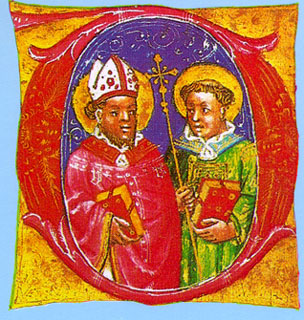
Hermagoras of Aquileia is considered the first bishop of Aquileia, northern Italy. Christian tradition states that he was chosen by Mark to serve as the leader of the nascent Christian community in Aquileia, and that he was consecrated bishop by Peter. Hermagoras and his deacon Fortunatus evangelized the area but were eventually arrested by Sebastius, a representative of Nero. They were tortured and beheaded.

Restituta is a Berber saint and martyr of the Roman Catholic and Eastern Orthodox Churches. She was said to have been born in Carthage or Teniza and martyred under Roman Emperor Diocletian. The location and date of her martyrdom are not precisely known. She sometimes is considered one of the Martyrs of Abitinae, Roman Province of Africa, a group of North Africans including Dativus, Saturninus, et alia, who were martyred in AD 304.
Gaudiosus was the Bishop of Tarazona, Spain. He is venerated as a saint in the Catholic Church.
Gaudiosus of Naples or Gaudiosus the African was a bishop of Abitina, a village near Carthage in present-day western Tunisia, in the Roman Africa Province.

Saint Severus was a bishop of Naples during the 4th and 5th centuries. He is considered the eleventh legitimate Catholic bishop of Naples, and the twelfth overall, succeeding Maximus. His episcopate ran from February 363 to April 29, 409, the traditional date of his death. Between the episcopates of Maximus and Severus, Zosimus, an Arian was established as Bishop, who was condemned as heretical by the Catholic Church.
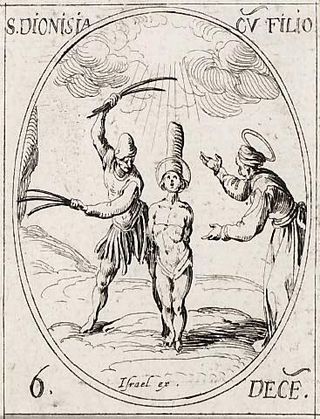
Denise, Dativa, Leontia, Tertius, Emilianus, Boniface, Majoricus, and Servus are venerated as martyrs by the Catholic Church. They were killed in the late 5th century during the persecution of Trinitarian Christians in Proconsular Africa by the Arian Vandals, according to Victor of Vita. These martyrs were killed during the reign of Arian king Hunneric.

October 13 - Eastern Orthodox liturgical calendar - October 15

Dionysius was bishop of Milan from 349 to 355. He is honoured as a Saint in the Catholic and Eastern Orthodox Churches and his feast day is 25 May.

The Catacombs of Saint Gaudiosus are underground paleo-Christian burial sites, located in the northern area of the city of Naples.
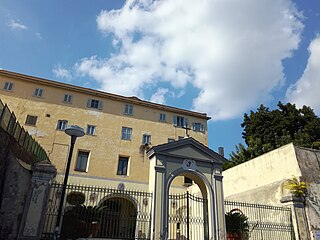
Sant'Eframo Vecchio is a church in the centre of Naples, Italy. It is said either to be on the burial site of saint Efrimus or on the site - either he was originally buried there in a 5th-century catacomb or his relics were translated there in the 13th century with those of Maximus of Naples and Fortunatus. There was a previous church on the site of unknown date, though the present structure was originally built in 1530 by the Capuchins. It has frequently been restored, such as the new maiolica facade of 1776 with five ovals by Tommaso Bruno. When the religious orders were suppressed after the Unification of Italy the Capuchins had to leave the church in 1865. The adjoining monastic buildings were acquired by the Monache delle Trentatré, who only returned them to the Capuchins in 1887.

















